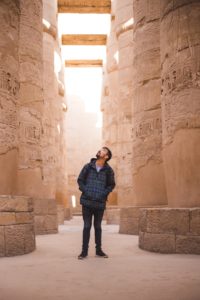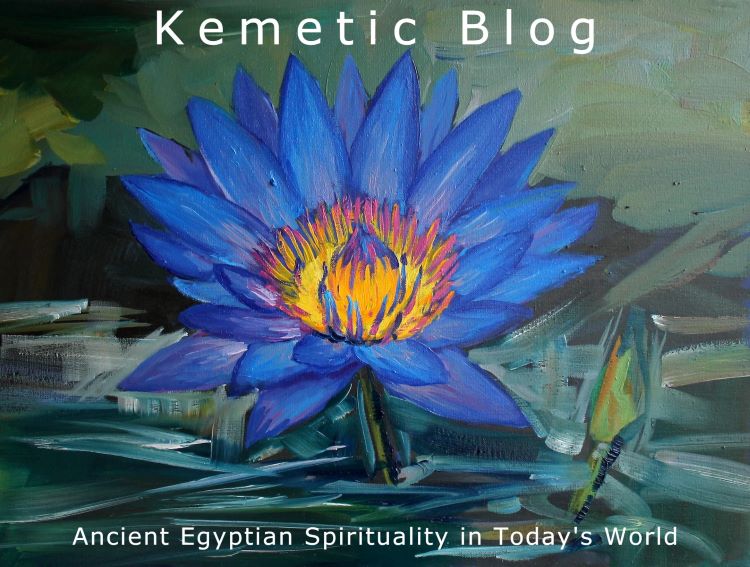
Photo by rosario janza on Unsplash
Lately, I’ve been writing about so many intermediate to advanced to even experimental topics, that I’ve forgotten to continue with my series on Kemetic spirituality for beginners. So sorry, guys! Please excuse my ramblings. This post is way over-due, so let’s jump right in.
Building and blending your bases of knowledge and experience
Alright, so you’ve set up a scared space (i.e. your very own Kemetic altar and shrine) you’ve made your first offerings and have spent some time with the netjeru — that is, with the ancient Egyptian deities — to build up your relationship with them. Excellent! In my humble opinion, this is the most important part of Kemetic Spirituality: living your life with the netjeru, who are themselves, living deities. Eventually, you’ll see that hanging out with the netjeru all the time is like wearing a set of training wheels, as we become deities ourselves but I don’t want to jump ahead! This is for beginners, so we’ll keep it at that. Besides, we love hanging out with the netjeru and they love us, too. (P.S. this is my own take on Kemetic Spirituality; there are others, and you’ll develop your own understanding, too as you progress).
Living your life with the netjeru creates an exchange of sacred energy that builds up a momentum; you are fuelling a spiritual engine that propels your life. Okay, all good? If not, please ask me questions in the comment section below. And don’t worry, the netjeru will help you navigate where you need to go — you’re not driving alone here and that’s why you need to cultivate and use your intuition and not rely solely on dusty old books and second-hand information. Having said that, the existing literature on ancient Egyptian religion definitely informs our practice and holds its place in Kemetic spirituality.
There’s a wealth of knowledge at our fingertips on ancient Egypt, including ancient Egyptian religion. Not so much on Kemetic spirituality but this is changing; you are changing that trajectory right now. Building your knowledge base will allow you to become a well-informed Kemetic practitioner. The author whom I started my own journey with was Sharon LaBorde. Sharon presents her knowledge in a very accessible and down-to-earth manner and has quite an approachable online presence. Check out her Kemetic Independent channel on Youtube, just beware of bullies and power-play in the live chats, which I unfortunately encountered and got quite affected by, so I no longer attend her live services. My review of her book, Following the Sun can be found here. I selected this author because I think she’s a very good starting point for newbies, yet remains appealing and informative to those who are more advanced. Who knows, you might have a completely different experience than I did, so I’m throwing her stuff out there simply because it’s good. Any friend of Tutankhamun is a friend of mine.
A fellow blogger, named Devo at The Twisted Rope, who was on the scene way before I ever came along, has made three recommendations as far as books to read that I’ll echo here because I couldn’t do it better myself:
Temple of the Cosmos by Jeremy Naydler introduces us to the Ancient Egyptian world-view, and gives us a solid introduction to ancient Egyptian religion. Devo points out that, as with most books, while this one wasn’t written with modern Kemetic practitioners in mind, it remains a good primer and 101 book.
To understand the basics of ancient Egyptian culture, Devo recommends Red Land, Black Land by Barbara Mertz. The writing style is easy to follow, plus the author gives a lot of information not found elsewhere.
If you’re looking for rituals that you can use in your own practice, try Eternal Egypt by Richard Reidy. Devo says, this book is a great resource for those who want examples of historically-derived rituals (as opposed to purely modern creations).
So far, because I’m so darned intuitive and interpretive (not to mention working full-time and finishing a degree part-time, in addition to writing this blog) I don’t have many of my own book recommendations to make, apart from Sharon LaBorde — except for one. Profane Egyptologists by Paul Harrison is a book I’m still in the process of reviewing at the time of this post, but you can read part one of my review here. Harrison’s work is an important cross-over effort; it’s a book written about Kemetic practitioners from an anthropologic view-point and calls for a change in the mindset and power structures that lie in the academic world of Egyptology. Harrison aims to destigmatise Kemetics and include Kemetic practitioners in the field as people with valuable lived experience to share. It’s a radical book, and I feel it’s very new, now, next. It’s written in a very academic style and presented as scientific research, so I will have to caution you on this! You might need to read a passage more than once to let it sink in. Other than that, it’s an awesome book.
All of the above is just the tip of the iceberg, but it’s a good place to start. I’m still bushwhacking my way through the literature myself at this point. Books on ancient Egypt are queued up on my bookshelf waiting to be read, including Raymond O. Faulkner’s translation of The Ancient Egyptian Book of the Dead (also translated as the book of going forth by day, which is quite a contrast). I can’t wait to finish my degree so I can read what I want to read, instead of what my uni wants me to read! Until then, I’ll be winging it with Isis, as I so often do.
And that brings us back to seeking your own mystical experiences.
Seeking your own mystical experiences
I write ad nauseum it seems on Subjective Mystical Experiences and Encounters (SMEEs), a term I invented in an effort to explain my own approach to Kemetic practice, and to also make this concept more accessible to others because it’s something you can do, too!
If you become too deeply rooted in rational, concrete thought, you’re going to fall into the trap of thinking that’s all there is. And it’s just not so! Kemetic spirituality is not a cerebral experience — it’s a mystical experience.
While building your knowledge base will give you an objective understanding of Kemetic spirituality, you’ll still be getting only half the story. We live in a world that seems to deny the value of subjective experience. While knowledge is power; experience is empowerment. There’s a difference.
Seek your own mystical experiences, which will empower your practice and allow you to reach your own insight into Kemetic spirituality. Having your own truth is incredibly important. Don’t look to others to always tell you what the truth is. The best way I know to facilitate this process of spiritual growth and autonomy is meditation. Like any new skill, meditation can be awkward and even exasperating at first, as you wrestle with intrusive thoughts.
If you become aware that your mind has started racing, it’s okay, just be mindful of it and let it go. Start again. Even if this process takes up your entire meditation time: where you attempt to meditate but your mind starts racing, you become aware of it and let it go. Allow yourself to cycle through it, as a stage in your growth. Focus on your breathing, and progressively relax. Eventually, you will get the hang of it; your higher spiritual centres will open, and your perseverance will pay off.
Healing and body work
Once you’ve opened and activated your spiritual centres, you’ll be able to meet with the netjeru and perceive them on the non-physical plane better than you could before. You’ll catch glimpses of their reality as well as receive messages. This is gold, and you deserve a gold-standard experience of your spiritual life. Just as we work on physical fitness and go to the gym, work on your spiritual fitness and meditate. Having your own mystical experiences with the deities, in my opinion, is at the heart of Kemetic spirituality. There’s even more than this available to all, but these are more advanced concepts I alluded to at the beginning of this post. First things first!
Remember to stay grounded. Immerse your bare feet into salt water, or even some bare grass if you can’t access a beach. Sit against a tree and ensure you have something to eat and drink. This will help you avoid what I call spiritual shock (aka light body symptoms), when we’ve downloaded a ton of spiritual information but we have trouble integrating that information and carrying that light in our physical bodies. If this happens to you, get grounded and ease off the spiritual side of things for a while. Give yourself time to consolidate everything you’ve learned and experienced so far. It’s an energetic adjustment taking place.
Consider spiritual healing modalities, such as Reiki and body work such as massage, though I think the subject warrants a separate article that I will have to write at some point. Remember to invoke the netjeru and ask for their protection, to avoid any interference from negative entities, who unfortunately exist in this world just to keep things interesting. Visualise yourself bathed in light and you’ll be right — if not, stop and seek guidance from a more experienced practitioner.
Does everything make sense? If not, please let me know! Okay, I think that’s enough for this instalment of Kemetic Spirituality for Beginners. Thank you, for reading Kemetic Blog. Stay safe and well. Best wishes to you and yours!
𓆸
© Scott Rose / Kemetic Blog – All Rights Reserved.

2 Comments
Amanda
August 20, 2022 at 8:12 amLooking forward to part 4
Scott Rose
August 20, 2022 at 9:29 amThanks for the reminder!